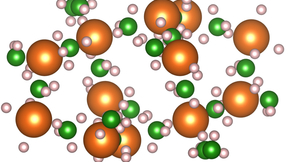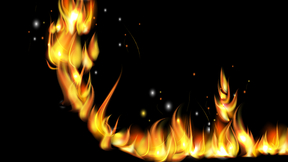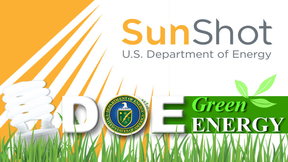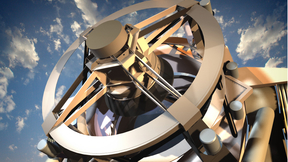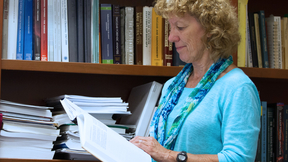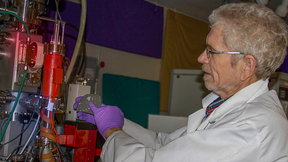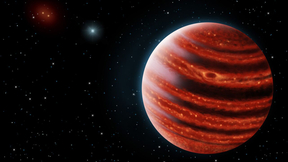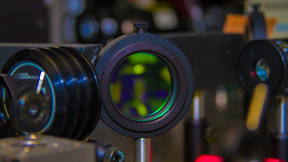Back
Physical and Life Sciences
Rare earths advance search for unified theory
Rare earth elements are used in computer hard drives, electric motors and to generate and amplify the lasers at Lawrence Livermore’s National Ignition Facility (NIF). Future applications may include serving as memory for a quantum computer or the basis for ultrastable clocks. In recent work by LLNL scientist Michael Hohensee and colleagues, the team shows that the…
It's solid: storing hydrogen in a new form
As part of a tri-lab consortium, Lawrence Livermore National Laboratory researchers will develop tools and understanding necessary for designing new solid-state materials for storing hydrogen gas.Storage of hydrogen onboard vehicles is one of the critical enabling technologies for hydrogen-fueled transportation systems that can reduce oil dependency and mitigate the long…
Better fluorescent lighting through physics
General Electric (GE), Lawrence Livermore National Laboratory (LLNL) and Oak Ridge National Laboratory (ORNL) have created new kinds of fluorescent lighting phosphors that use far less rare-earth elements than current technology.Rare-earth elements are hard to come by. The United States has access to a limited amount of rare-earth elements and relies on imports.Today the…
Thermite Research Heats Up
Energetic materials—explosives, propellants, and pyrotechnics—are substances that store and release large amounts of chemical energy. They are made by either physically mixing solid oxidizers and fuels to produce a composite energetic material, such as gunpowder, or by creating a molecule that contains both oxidizing and fuel components, such as TNT.
Plant debris decomposition tied to manganese
The decomposition of plant debris (litter) is a fundamental process that regulates the release of nutrients for plant growth and the formation of soil organic matter in forest ecosystems.A strong correlation has previously been observed between litter manganese (Mn) content and decomposition rates across a variety of forest ecosystems. However, the mechanisms underlying Mn…
New 'stealth dark matter' theory may explain mystery of the universe's missing mass
Lawrence Livermore National Laboratory (LLNL) scientists have come up with a new theory that may identify why dark matter has evaded direct detection in Earth-based experiments.A group of national particle physicists known as the Lattice Strong Dynamics Collaboration, led by a Lawrence Livermore National Laboratory team, has combined theoretical and computational physics…
Research lends new view of the Earth's core
There is more oxygen in the core of Earth than originally thought.Lawrence Livermore geologist Rick Ryerson and international colleagues discovered some new findings about Earth’s core and mantle by considering their geophysical and geochemical signatures together.This research provides insight into the origins of Earth’s formation.Based on the higher oxygen concentration…
Carbon research may boost nanoelectronics
The smallest of electronics could one day have the ability to turn on and off at an atomic scale.Lawrence Livermore National Laboratory scientists have investigated a way to create linear chains of carbon atoms from laser-melted graphite. The material, called carbyne, could have a number of novel properties, including the ability to adjust the amount of electrical current…
LLNL researcher takes aim at solar-cell reliability
A Lawrence Livermore National Lab engineer has been awarded $570,000 through the Department of Energy SunShot Initiative to explore spectroscopic technology as a means of detecting moisture buildup in solar photovoltaic (PV) cells. Over the next two years, Mihail Bora, a Materials Engineering Division (MED) research team member at the Lab, will try to prove that spectral…
Nerine Cherepy and Michael Pivovaroff elected senior members of optics and photonics society
LLNL researchers Nerine Cherepy and Michael Pivovaroff are among the 171 new senior members of SPIE, the international society for optics and photonics. Cherepy is being recognized for her "achievements in discovery and development of new scintillator materials and detectors," and Pivovaroff for his "achievements in design, fabrication and use of reflective X-ray optics."…
Construction to begin on world's largest camera
The Department of Energy has approved the start of construction for a 3.2-gigapixel digital camera — the world’s largest — for the Large Synoptic Survey Telescope (LSST).The construction milestone, known as Critical Decision 3, is the last major approval decision before the acceptance of the finished camera. Construction of the telescope was previously approved by the…
Lab scientist receives chemical society award
Laboratory geochemist Annie Kersting, who serves as the director of the Lab’s Glenn T. Seaborg Institute, has been selected to receive the 2016 American Chemical Society’s Francis P. Garvan-John M. Olin Medal for distinguished service to chemistry.The medal recognizes outstanding scientific achievement, leadership and service to chemistry by women and is a national award…
Supercapacitors Yield Energetic Secrets
In the race for advanced energy storage systems, researchers are increasingly turning to the supercapacitor, a seemingly straightforward device made attractive by its many advantages over most batteries, including higher power density, faster charge–discharge cycling, enhanced safety, lower cost, and better endurance.
Former Lawrence Livermore astrophysicist appointed director of UC Observatories
Longtime Lawrence Livermore National Laboratory astrophysicist Claire Max has shifted her focus to a new frontier as the recently appointed director of the University of California Observatories (UCO).After serving at the post on an interim basis for the past year, Max’s appointment to the directorship began July 1. Over the next five years, she will work with faculty,…
Giant galaxy collision triggered 'radio phoenix'
Astronomers have found evidence for a faded electron cloud "coming back to life," much like the mythical phoenix, after two galaxy clusters collided.This "radio phoenix," so-called because the high-energy electrons radiate primarily at radio frequencies, is found in Abell 1033. The system is located about 1.6 billion light years from Earth.By combining data from NASA’s…
Research award named after late LLNL scientist
The first Dr. Ian Hutcheon Post-Doctoral Fellowship award, to support research in nuclear forensics as part of the Department of Homeland Security (DHS) Domestic Nuclear Detection Office’s (DNDO) National Nuclear Forensics Expertise Development Program, has been established. The fellowship honors the late Hutcheon, who significantly advanced America’s nuclear forensics…
Nanocrystals don't add up for reactor materials
Lawrence Livermore researchers have found that nanocrystalline materials do not necessarily resist radiation effects in nuclear reactors better than currently used materials.As researchers hunt for materials with the ability to withstand prolonged radiation damage, the use of nanostructured materials, with high interfacial area to absorb radiation-induced defects, has been…
Lawrence Livermore scientists' discovery of new young planet provides insight into Jupiter
For the first time, Lawrence Livermore scientists, as part of an international team, have discovered the most Jupiter-like planet ever seen in a young star system, lending clues to understanding how planets formed around our sun.Using a new advanced adaptive optics device on the Gemini Planet Imager (GPI) on the Gemini South Telescope in Chile, the team took an image of…
Researchers reveal new electron ring formations
Laser wakefield acceleration, a process where electron acceleration is driven by high-powered lasers, is well-known for being able to produce high-energy beams of electrons in tabletop-scale distances. However, in recent experiments, a team of scientists from Lawrence Livermore National Laboratory (LLNL) and the University of California, Los Angeles (UCLA) revealed new,…
Berni Alder: A pioneer of the times
Father of molecular dynamics to celebrate 90th birthday, 60th anniversary at the LaboratoryBerni Alder was born in Germany, but was a Swiss citizen. In 1932, his family moved to Zurich, just before Hitler came to power.In 1941, when he was 16 years old, he fled Switzerland right before the United States entered World War II and took a sealed train through occupied France…



